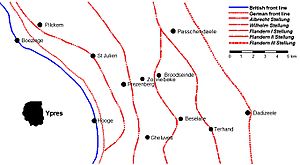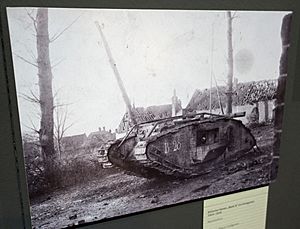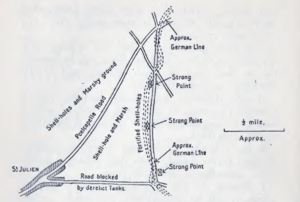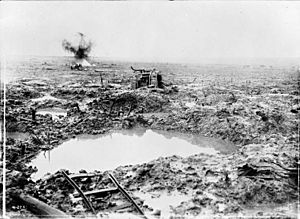Action of the Cockcroft facts for kids
Quick facts for kids Action of the Cockcroft, 19 August 1917 |
|||||||
|---|---|---|---|---|---|---|---|
| Part of the Third Battle of Ypres of the First World War | |||||||
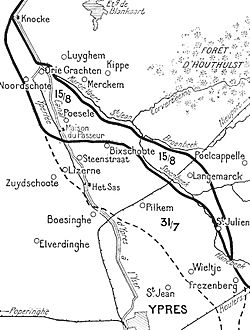 Front line after Battle of Langemarck, 16–18 August 1917 |
|||||||
|
|||||||
| Belligerents | |||||||
| Commanders and leaders | |||||||
| Sir Douglas Haig Hubert Gough |
Crown Prince Rupprecht Sixt von Armin |
||||||
| Units involved | |||||||
| 1/8th Battalion Royal Warwick G Battalion, 1st Tank Brigade |
|||||||
| Strength | |||||||
| 1 infantry battalion, 11 tanks | |||||||
| Casualties and losses | |||||||
| infantry: 15 wounded tank crews: 2 killed, 13–14 wounded |
c. 100 and 30 POW | ||||||
The Action of the Cockcroft was a small but important battle that happened on August 19, 1917. It was part of the larger Third Battle of Ypres during World War I. This fight took place on the Western Front in Belgium.
During the earlier Battle of Langemarck (August 16–18, 1917), British soldiers could not reach their goals. They were stopped by German machine guns hidden in strong concrete bunkers called pillboxes. These pillboxes were part of the German defensive line. To prepare for another big attack, British commanders decided to launch smaller, local attacks. The goal was to get closer to the German lines.
On August 19, 1917, at 4:45 a.m., British tanks led the way. Seven tanks moved forward, hidden by smoke and the noise of low-flying British planes. Soldiers from the 1/8th Battalion, Royal Warwickshire Regiment, followed the tanks. Their job was to take over the strong points once the tanks had dealt with the German defenders.
Most German soldiers ran away when they saw the tanks. But at places like Triangle Farm, Maison du Hibou, and the Cockcroft, the Germans fought back. About 100 German soldiers were killed or wounded, and 30 were captured. The British had fewer casualties: two tank crew members were killed, 13–14 were wounded, and 15 infantry soldiers were wounded. This attack showed how useful tanks could be, especially when used in new ways.
Contents
What Happened Before?
German Defenses
In 1917, the German army used a smart defense system. They had several lines of trenches and strong points. The first lines were lightly held, with listening posts in the "no-man's-land" between armies. Further back, they had stronger positions with machine-gun nests.
Behind these were even stronger lines with more artillery. The deepest line, called the Wilhelmstellung, had reserve soldiers ready to counter-attack. This system was designed to slow down attackers and wear them out. It also allowed German artillery to fire on British troops as they advanced.
The Battle of Langemarck
The Battle of Langemarck happened just before the Action of the Cockcroft. On August 16, British troops attacked at 4:45 a.m. They had planned to use tanks, but the ground was too muddy. The tanks had to turn back.
The British soldiers faced heavy machine-gun fire from German strongholds. Places like Hillock Farm and Maison du Hibou caused many problems. Even though some areas were captured, the British suffered many losses. The Germans used their pillboxes and artillery very effectively. This meant the British could not reach their main goals.
After this battle, British commanders realized they needed new tactics. The ground was very muddy, and German defenses were strong. They needed a way to deal with the hidden machine guns in the pillboxes.
British Plans for the Attack
After the Battle of Langemarck, British commanders met to discuss what to do next. They knew their troops had been stopped by German pillboxes. General Hubert Gough, the Fifth Army commander, was not happy. He wanted to find a way to reach the final objectives.
The commanders decided to try smaller, focused attacks. The goal was to move their front line closer to the main German defenses. This would give them a better starting point for a bigger attack later. They also needed to find out exactly where the German strong points were.
The British artillery had tried to destroy the German bunkers before. But normal shells were not strong enough. Heavy artillery was not accurate enough. However, a dry spell had started, making some roads usable for tanks.
A British tank commander, Colonel Christopher Baker-Carr, suggested using tanks. He believed tanks could capture the strong points with fewer British casualties. He proposed using a smoke screen instead of artillery fire. This would hide the tanks as they moved forward.
The plan was for seven camouflaged tanks to drive forward under a smoke screen. Their noise would be covered by low-flying British planes. The tanks would attack the German strong points from behind, where they were weakest. Infantry soldiers would follow the tanks, ready to take over the positions.
Each strong point, like Maison du Hibou and the Cockcroft, would be attacked by one tank. Other tanks would be in reserve. Once a tank signaled success, infantry would rush in to secure the area. This was a new and bold plan for using tanks.
The Action of the Cockcroft
On August 19, 1917, at 4:45 a.m., the attack began. Only seven tanks were ready; others had broken down or gotten stuck. The tanks moved slowly towards Hillock Farm. It took them until 6:00 a.m. to reach it. The farm was empty, and British soldiers quickly took it over.
One tank, G. 29, reached Triangle Farm. It then moved towards Maison du Hibou. The tank fired its powerful 6-pounder gun. About sixty German soldiers ran out of Maison du Hibou. Half were shot, and the rest were captured by the British infantry.
Another tank, G. 34, headed for the Cockcroft, the furthest target. It took until 6:45 a.m. to reach it. The tank and German defenders exchanged machine-gun fire for about 15 minutes. Then, about fifty Germans came out of the Cockcroft. Most were killed or captured by the tank's machine guns.
Tank G. 29 later got stuck in the mud. Its crew kept firing until the tank sank too deep. The crew then took their machine guns and joined the infantry. At Triangle Farm, the Germans fought hand-to-hand until the British infantry, supported by a tank, took over.
At other strong points, the sight of tanks alone made the Germans run. The British were able to set up new outposts. This attack was a big success for the British. The 1/8th Warwick infantry had only 15 wounded. The tank crews had two killed and eleven wounded. The Germans suffered about 100 casualties and 30 prisoners. This was much fewer casualties than expected.
Aftermath
Casualties
The British had very few casualties in this action. Records show 15 infantry soldiers were wounded. Among the tank crews, two were killed and 11 to 14 were wounded. This was a much smaller number than the 600–1,000 casualties that had been expected for such an attack.
What Happened Next
After the success of the Cockcroft action, the British continued their efforts. On August 20, they used gas and smoke in another area. On August 21, they pushed their lines forward slightly.
On August 22, the British launched another attack to get closer to the German Wilhelmstellung line. However, this attack was not as successful. Many tanks got stuck in the mud or were hit by shells. The infantry faced heavy machine-gun fire and suffered many losses. This showed that while tanks could be very effective, the muddy conditions and strong German defenses still made fighting very difficult.
Images for kids
See Also
- Third Battle of Ypres
- Battle of Langemarck (1917)
- Tanks in World War I


